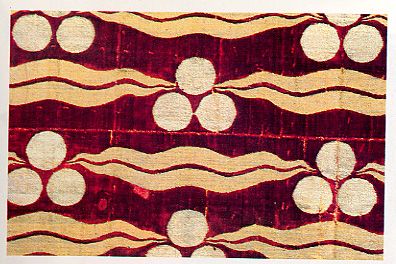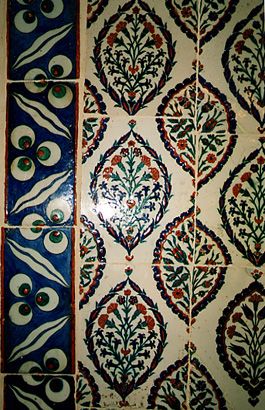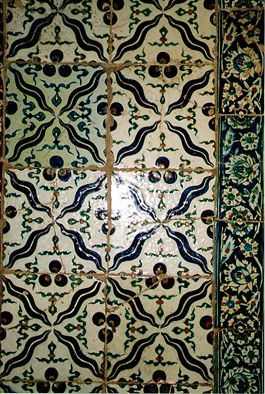daniel.d@infonie.be
One of the piece illustrated in by R. John in this Salon is a nice 17th
century piece with the cintamani pattern on a blue ground. According to
Nevber Gürsu (1), the origin of the motifs and their symbolic forms
dates back to the Buddhist period in China, where it represents pearls
arising from the wave. The cintamani pattern or three leopard dot and
tiger stripes, a well known decorative motif which appeared in Ottoman art
from the 15th century onwards, was used in all the various branches of
court art. This motif was first used as a symbol of power but gradually it
has been used only as a decorative motif, the triple leopard dot and the
tiger stripes being used together or separately. Here is a picture from
one of the two oldest specimen of fabrics of the Ottoman art. It’s a
chatma (brocaded silk velvet) fabric of the second half of the 15th
century, woven in Bursa and preserved in the Washington Textile Museum. It
is illustrated in Nevber Gürsu book (fig 6) and in Mackie 1974 – (fig 14).
 The metallic threads
used for the design are obtained by wrapping ivory or yellow silk with
silver. One characteristic of the Ottoman art is the stylistic homogeneity
embracing all the various different artistic branches, which were under
government supervision. Here are some photos I made when I went some
months ago to Istanbul, of the cintamani pattern used in Iznik tiles. As I
visited a lot of places and did a lot of photos, I am no longer certain of
their origin, but I think they are from tiles in the Topkapi Saray Museum.
They illustrate various evolution of the pattern along the centuries. The metallic threads
used for the design are obtained by wrapping ivory or yellow silk with
silver. One characteristic of the Ottoman art is the stylistic homogeneity
embracing all the various different artistic branches, which were under
government supervision. Here are some photos I made when I went some
months ago to Istanbul, of the cintamani pattern used in Iznik tiles. As I
visited a lot of places and did a lot of photos, I am no longer certain of
their origin, but I think they are from tiles in the Topkapi Saray Museum.
They illustrate various evolution of the pattern along the centuries.    The following is a picture
of an exceptional 17th century northwest Anatolian bohca from the Palazzo
Reale Collection, illustrated (fig6) in "Sovrani Tappeti", it shows one of
the myriad interpretations of this motif. The following is a picture
of an exceptional 17th century northwest Anatolian bohca from the Palazzo
Reale Collection, illustrated (fig6) in "Sovrani Tappeti", it shows one of
the myriad interpretations of this motif.  Thanks, Daniel FOOTNOTE
(1) Nevber Gürsu, "The Art of Turkish Weaving – Designs through the
Ages". page 180 Thanks, Daniel FOOTNOTE
(1) Nevber Gürsu, "The Art of Turkish Weaving – Designs through the
Ages". page 180 |
 The metallic threads
used for the design are obtained by wrapping ivory or yellow silk with
silver. One characteristic of the Ottoman art is the stylistic homogeneity
embracing all the various different artistic branches, which were under
government supervision. Here are some photos I made when I went some
months ago to Istanbul, of the cintamani pattern used in Iznik tiles. As I
visited a lot of places and did a lot of photos, I am no longer certain of
their origin, but I think they are from tiles in the Topkapi Saray Museum.
They illustrate various evolution of the pattern along the centuries.
The metallic threads
used for the design are obtained by wrapping ivory or yellow silk with
silver. One characteristic of the Ottoman art is the stylistic homogeneity
embracing all the various different artistic branches, which were under
government supervision. Here are some photos I made when I went some
months ago to Istanbul, of the cintamani pattern used in Iznik tiles. As I
visited a lot of places and did a lot of photos, I am no longer certain of
their origin, but I think they are from tiles in the Topkapi Saray Museum.
They illustrate various evolution of the pattern along the centuries. 

 The following is a picture
of an exceptional 17th century northwest Anatolian bohca from the Palazzo
Reale Collection, illustrated (fig6) in "Sovrani Tappeti", it shows one of
the myriad interpretations of this motif.
The following is a picture
of an exceptional 17th century northwest Anatolian bohca from the Palazzo
Reale Collection, illustrated (fig6) in "Sovrani Tappeti", it shows one of
the myriad interpretations of this motif.  Thanks, Daniel FOOTNOTE
(1) Nevber Gürsu, "The Art of Turkish Weaving – Designs through the
Ages". page 180
Thanks, Daniel FOOTNOTE
(1) Nevber Gürsu, "The Art of Turkish Weaving – Designs through the
Ages". page 180 Michael Seidman said in this TM Rug Morning presentation that
the meanings behind the cintamani design have been conjectured about
extensively. In this short article some of these interpretations are
presented. First, the design is sometimes seen to be “of Far Eastern
Buddhist origin, where it consisted of three flaming pearls placed over
sea waves (hence the wavy bands).” The passage also says that Ellis
suggests that “the group of three balls,” “eyes” and all may represent the
Triple Jewel of the Far East and the stripes the lips of Buddha. It is
further indicated that the design “was to become an Islamic symbol of good
luck and protection from the evil eye.” For a time it was considered to be
the badge of Timur. Regards, R. John Howe
Michael Seidman said in this TM Rug Morning presentation that
the meanings behind the cintamani design have been conjectured about
extensively. In this short article some of these interpretations are
presented. First, the design is sometimes seen to be “of Far Eastern
Buddhist origin, where it consisted of three flaming pearls placed over
sea waves (hence the wavy bands).” The passage also says that Ellis
suggests that “the group of three balls,” “eyes” and all may represent the
Triple Jewel of the Far East and the stripes the lips of Buddha. It is
further indicated that the design “was to become an Islamic symbol of good
luck and protection from the evil eye.” For a time it was considered to be
the badge of Timur. Regards, R. John Howe Bertram
Bertram